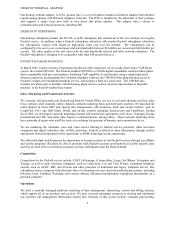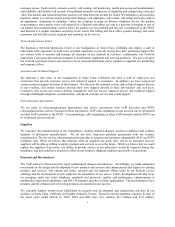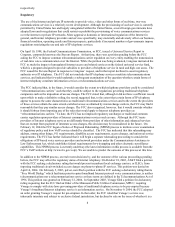8x8 2005 Annual Report Download - page 19
Download and view the complete annual report
Please find page 19 of the 2005 8x8 annual report below. You can navigate through the pages in the report by either clicking on the pages listed below, or by using the keyword search tool below to find specific information within the annual report.16
policies affect our reported and expected financial results.
Use of Estimates
The preparation of the consolidated financial statements, in conformity with accounting principles generally
accepted in the United States, requires management to make estimates and assumptions that affect the reported
amounts of assets, liabilities and equity and disclosure of contingent assets and liabilities at the date of the financial
statements and the reported amounts of revenues and expenses during the reporting period. On an on-going basis, we
evaluate our estimates, including, but not limited to, those related to bad debts, valuation of inventories, and
litigation and other contingencies. We base our estimates on historical experience and on various other assumptions
that are believed to be reasonable under the circumstances, the results of which form the basis for making judgments
about the carrying value of assets and liabilities that are not readily apparent from other sources. Actual results could
differ from those estimates under different assumptions or conditions.
In addition to evaluating estimates relating to the items discussed above, we also consider other estimates, including,
but not limited to, those related to bad debts, the valuation of inventories, income taxes, and litigation. We base our
estimates on historical experience and on various other assumptions that are believed to be reasonable under the
circumstances, the results of which form the basis for making judgments about the carrying value of assets,
liabilities and equity that are not readily apparent from other sources. Actual results could differ from those
estimates under different assumptions or conditions. Additional information regarding risk factors that may impact
our estimates is included below under "Factors that May Affect Future Results."
Revenue Recognition
Our revenue recognition policies are described in Note 1 to the consolidated financial statements in Part II, Item 8 of
this Report. As described below, significant management judgments and estimates must be made and used in
connection with the revenue recognized in any accounting period. Material differences may result in the amount and
timing of our revenue for any period if our management made different judgments or utilized different estimates.
We defer recognition of new subscriber revenue from our Packet8 service offerings until the acceptance period has
expired. New customers may terminate their service within thirty days of order placement and receive a full refund
of fees previously paid. As we have been providing our Packet8 service for a limited period of time, we have not
developed sufficient history to apply a return rate and reserve against new order revenue. Accordingly, we defer
new subscriber revenue for thirty days to ensure that the thirty day acceptance period has expired.
Emerging Issues Task Force (EITF) consensus No. 00-21, “Accounting for Revenue Arrangements with Multiple
Deliverables” requires that revenue arrangements with multiple deliverables be divided into separate units of
accounting if the deliverables in the arrangement meet specific criteria. In addition, arrangement consideration must
be allocated among the separate units of accounting based on their relative fair values, with certain limitations. The
provisioning of the Packet8 service with the accompanying desktop terminal adapter or other customer premise
equipment constitutes a revenue arrangement with multiple deliverables. In accordance with the guidance of EITF
No. 00-21, we allocate Packet8 revenues, including activation fees, among the customer premise equipment and
subscriber services. Revenues allocated to the customer premise equipment are recognized as product revenues at
the end of thirty days after order placement, provided the customer does not cancel their Packet8 service. All other
revenues are recognized as license and service revenues when the related services are provided. We defer the cost
of goods sold of products sold for which the end customer or distributor has a right of return. The cost of the
products sold is recognized, contemporaneously with the recognition of revenue, when the subscriber has accepted
the service.
At the time of each revenue transaction we assess whether the revenue amount is fixed and determinable and
whether or not collection is reasonably assured. We assess whether the fee is fixed and determinable based on the
payment terms associated with the transaction. If a significant portion of a fee is due after our normal payment
terms, which are thirty to ninety days from invoice date, we account for the fee as not being fixed and determinable.
In these cases, we recognize revenue as the fees become due. We assess collection based on a number of factors,
including past transaction history with the customer and the credit-worthiness of the customer. We generally do not
request collateral from our customers. If we determine that collection of a fee is not reasonably assured, we defer the
fee and recognize revenue at the time collection becomes reasonably assured, which is generally upon receipt of
payment.
























